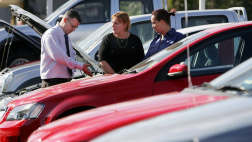AMERICANS pay about half of what we pay for new cars and we're not happy. It's not only the customer who's not happy - even the car distributors and dealers are spitting chips.
The enormous difference surfaced in the past few months when the Australian dollar reached parity with the US currency. Immediately we started asking why a Lexus LS460 costs an Australian a sizeable $191,200 - but an American pays $66,230.That's about a third of what we pay.
It's nothing to do with Lexus and the luxury brand isn't alone - all cars are cheaper in the US. We priced a Porsche Carrera S at $88,800 in the US - the same price as what we pay for a base-model diesel Land Cruiser GXL.But in Australia, the Porche costs us $282,800 - three times the US price.
As the words "rip off" resonate in our ears, we applied the same comparison to Mercedes-Benz and still we're looking at paying three times the price for luxury cars.
Mercedes-Benz Australia spokesman David McCarthy says there are crucial differences between the two markets and that flows onto the retail prices.
"Basically, we pay more tax," he says. "There is GST, luxury-car tax and import tax on each car.
"That's the starting point. Australia is a tiny market - we have a one-million a year vehicle market, the US is about 13 million. You get a discount for buying in volume.
"Australia is a small market but it is geographically huge and needs similar levels of personnel and nationwide support and service as the US.
"Then we have specific emission and design regulations which Mercedes-Benz at the factory has to engineer and comply. We, Mercedes-Benz Australia, pays for that - not Mercedes in Germany. So that gets passed on to the customer.
"Our geographical isolation means we carry cars on shipping routes that aren't well travelled, so that costs extra. "The other important factor is model range. We sell everything from a Smart Fortwo to a 140-tonne truck and everything - cars, vans, trucks - in between.
"The US has a much smaller model range. For example, they have no four-cylinder engine versions available in the C-Class and E-Class and have no A-Class or B-Class models."
Porsche Australia spokesman Paul Ellis mirrors what McCarthy outlines. He says there's "about $100,000" in taxes in the Carrera S.
"The luxury-car tax is a high-end tax that's only applied to cars," he says. "It's not on yachts, jewellery or electronics - just cars - and I think that's because the government sees the car industry as a soft touch.
"The Australian Government imposes more taxes on luxury cars than any other economically established and mature market in the world."
Ellis says that's not all. He says that what we get in Australia is a far, far better product than the Americans. "In the US you basically get a cardboard box and steering wheel for your $88,800," he says. "Our cars have a much, much higher level of standard equipment."
McCarthy agrees saying the S-Class, for example, for Australia is the best-specced model in the world.
Ellis adds that buying power is a big contributor to the cheap US prices. "The US sells 30 times the number of Porsches we do," he says.
"So it can ask - and get - a better buying price from the factory. "Then there's market positioning. The 911 rivals are relatively more affordable in the US. You have to price your car in and around your competitors or you don't get on buyers' shopping lists."
The price differences also comes down to what people can afford. We did a check of average wages in Australia and compared them to the US.
Surprisingly, relative to the US wages, we are paid more. The average yearly earnings in Australia for 2010 was $56,950. In the US, it was $46,326.
More than 50 per cent of working Americans are paid less than $45,000 a year. "It's what people can or cannot afford to pay," says McCarthy. "It's interesting to note that the margins that we operate on - that is the profit to the dealer - is the same as other markets. So even though we pay three times more, the dealers are getting about the same."
Price differences
Honda Jazz 1.5
($A19,190) — $US15,100 (-21%)
Mini Cooper S
($A42,850) — $US22,300 (-48%)
Toyota Corolla Conquest
($A24,490) — $US16,520 (-33%)
Mazda3 Maxx Sport
($A26,320) — $US20,045 (-24%)
Toyota Prius
($A39,900) — $US21,650 (-46%)
Volkswagen Golf 103TDI
($A34,490) — $US23,885 (-31%)
Toyota Camry Sportivo
($A33,990) — $US23,590 (-31%)
Mazda6 Classic
($A31,750) — $US22,635 (-29%)
Subaru Liberty Premium wagon
($A40,990) — $US25,295 (-38%)
Honda Accord V6
($A49,990) — $US27,355 (-45%)
Mazda CX-9 Luxury
($A57,015) — $US32,445 (-43%)
Toyota Kluger KX-S
($A55,490) — $US34,750 (-37%)
Volvo XC60 T6
($A65,950) — $US38,400 (-42%)
BMW X5 35i
($A103,900) — $US46,300 (-55%)
Note: Some cars are built in the US. Specifications may not precisely equate.







.jpg)
.jpg)
.jpg)

.jpg)


.jpg)
.jpg)




Comments